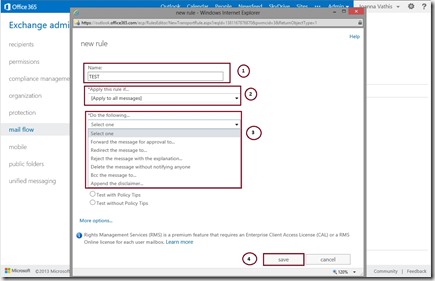Using Transport rules, you can look for specific conditions in messages that pass through your organization and take action on them. Transport rules let you apply messaging policies to email messages, secure messages, protect messaging systems, and prevent information leakage.
Many organizations today are required by law, regulatory requirements, or company policies to apply messaging policies that limit the interaction between recipients and senders, both inside and outside the organization. In addition to limiting interactions among individuals, departmental groups inside the organization, and entities outside the organization, some organizations are also subject to the following messaging policy requirements:
-
Preventing inappropriate content from entering or leaving the organization -
Filtering confidential organization information -
Tracking or archiving copying messages that are sent to or received from specific individuals -
Redirecting inbound and outbound messages for inspection before delivery -
Applying disclaimers to messages as they pass through the organization
Overview of Transport rules
Transport rules are similar to the Inbox rules that are available in many email clients. The main difference between Transport rules and rules you would set up in a client application such as Outlook is that Transport rules take action on messages while they’re in transit as opposed to after the message is delivered. Transport rules also contain a richer set of conditions, exceptions, and actions, which provides you with the flexibility to create a customized rule. You can create up to 100 Transport rules in order to implement your business-rule compliance.
The following list summarizes the basic workflow for Transport rules:
-
You create Transport rules to meet your business needs. -
As messages go through your organization, the Transport rules agent is invoked. The Transport rules agent is a special component that checks messages against the Transport rules you create. -
The Transport rules agent scans the message, and if the message fits the conditions you specify in a Transport rule, it takes the specified action on that message.
Transport rule components
Transport rules consist of the following components:
-
Conditions Use Transport rule conditions to specify the characteristics of messages to which you want to apply a Transport rule action. Conditions consist of one or more predicates that specify the parts of a message that should be examined. Some predicates examine message fields or headers, such as the To, From, or Cc fields. Other predicates examine message characteristics such as message subject, body, attachments, message size, and message classification. Most predicates require that you specify a comparison operator, such as equals, doesn’t equal, or contains, and a value to match. -
Exceptions Exceptions are based on the same predicates used to build Transport rule conditions. However, unlike conditions, exceptions identify messages to which Transport rule actions shouldn’t be applied. Exceptions override conditions and prevent actions from being applied to an email message, even if the message matches all configured conditions. -
Actions Actions are applied to messages that match the conditions and don’t match any exceptions defined in the Transport rule. Transport rules have many actions available, such as rejecting, deleting, or redirecting messages, adding additional recipients, adding prefixes in the message subject, or inserting disclaimers in the message body.
For a complete list of Transport rule predicates, see Transport Rule Predicates. The list of predicates is also available in the Transport rule dialog in the EAC. If you use the Shell, you can retrieve the list of predicates by using the Get-TransportRulePredicate cmdlet.
For a complete list of Transport rule actions available, see Transport Rule Actions. The list of actions is also available in the Transport rule dialog box in the EAC. If you use the Shell, you can retrieve the list of actions by using the Get-TransportRuleAction cmdlet.
To create Transport Rules in Office 365, first must log into Office 365portal https://portal.microsoftonline.com/default.aspx and go to the following location:
-
Go to Admin and choose Exchange
2. Navigate to Mail Flow (from the left site) and choose Rules
This is where any and all transport rules can be created and applied
Once you are in the rules area of the O365 portal, you perform the following:
1. Press the + sign and then select Create a new rule
2. Choose a name for this rule and choose the rule for your condition (depends what you want to achieve)
3. Choose the option that apply for your condition and after you finished click on Save
4. Now, this rule is ready to be applied to all emails coming through your Office 365 tenant.
For comprehensive information on Transport Rules as a whole, refer to the following link: http://technet.microsoft.com/en-us/library/dd351127(v=exchg.150).aspx
Outlook Rules
A rule is an action that Microsoft Outlook runs automatically on incoming or outgoing messages, based on conditions that you have specified.
Rules help reduce manually filing or taking the same action when a similar message arrives. Unlike Quick Steps, rules typically are always on and run automatically. For example, when a message is received from a specified person, it’s automatically moved to the folder that you designate.
The Rules Wizard helps you design rules to manage messages. Rules fall into one of two categories — organization and notification.
The Rules Wizard includes templates for the most frequently used rules, which include the following:
Stay Organized These rules help you file and follow up on messages. For example, you can create a rule for messages from a specific sender, such as Anne Weiler, with the word “sales” in the Subject line, to be flagged for follow-up, categorized as Sales, and moved to a folder named Anne’s Sales.
Stay Up to Date These rules notify you in some way when you receive a particular message. For example, you can create a rule that automatically sends a message to a mobile device when you receive a message from a family member.
Start from a blank rule These are rules that you create without the aid of a rule template and that you can completely customize.
Create a rule
Outlook includes rule templates for common scenarios. Use these rule templates, or create design your own custom rules.
1. Click the File tab, click Manage Rules & Alerts
2. In the Rules and Alerts dialog box, on the E-mail Rules tab, click New Rule
3. Follow the wizard and at the end click Finish
Additional Information:
Manage email messages by using rules
http://office.microsoft.com/en-us/outlook-help/manage-email-messages-by-using-rules-HA102749402.aspx










0 Comments
Recommended Comments
There are no comments to display.